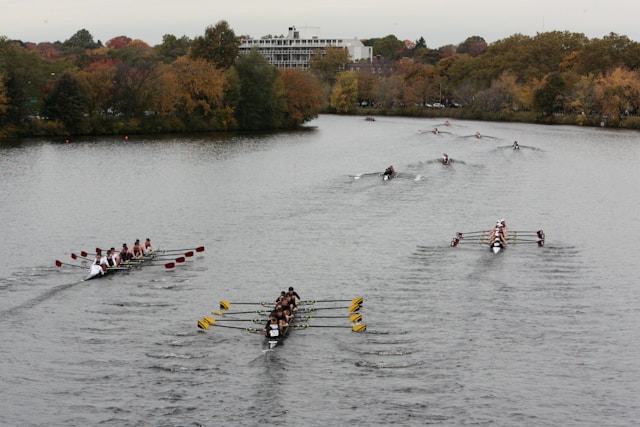Boat racing has always been a sport of innovation, with athletes and engineers constantly seeking ways to gain a competitive edge on the water. Over the years, advancements in technology have revolutionized the sport, leading to faster, more efficient boats and pushing the boundaries of performance. In this comprehensive exploration, we delve into the evolution of boat racing technology, examining key innovations that have shaped the sport and transformed the way we race on the water.
1. Hull Designs
Traditional vs. Modern Hulls In the early days of boat racing, hull designs were largely based on traditional shapes optimized for stability and maneuverability. However, modern racing hulls feature sleek, streamlined profiles designed to minimize drag and maximize speed. Advances in hydrodynamics and computational fluid dynamics (CFD) have allowed designers to create hulls with optimized shapes and surface finishes, resulting in superior performance on the water.
Hydrofoils and Foiling Technology One of the most significant recent innovations in hull design is the use of hydrofoils, which lift the boat’s hull out of the water to reduce drag and increase speed. Foiling technology has revolutionized sailing and hydroplane racing, enabling boats to achieve speeds previously thought impossible. By harnessing the power of hydrodynamics, foiling boats can “fly” above the water, dramatically reducing drag and friction and reaching unprecedented speeds.
2. Materials and Construction
Carbon Fiber and Composite Materials The introduction of carbon fiber and other advanced composite materials has revolutionized boat construction, offering unparalleled strength-to-weight ratios and durability. Carbon fiber hulls are lighter, stiffer, and more resistant to fatigue than traditional materials like wood or fiberglass, allowing for faster acceleration and improved performance. Composite materials also provide greater flexibility in hull design, enabling designers to create complex shapes and optimize aerodynamics for maximum speed and efficiency.
3D Printing and Additive Manufacturing Recent advancements in 3D printing and additive manufacturing have opened up new possibilities for boat construction, allowing designers to create lightweight, customized components with unprecedented precision and efficiency. Additive manufacturing techniques enable the rapid prototyping and production of complex geometries, reducing lead times and costs while improving performance and durability. From hulls and foils to rigging and accessories, 3D printing is revolutionizing the way boats are designed, built, and raced.
3. Propulsion Systems
Hybrid and Electric Powertrains As the world shifts towards renewable energy sources, boat racing is also embracing alternative propulsion systems, including hybrid and electric powertrains. Electric motors offer silent, emissions-free propulsion and instant torque delivery, making them ideal for high-performance racing applications. Hybrid systems combine internal combustion engines with electric motors to optimize fuel efficiency and power output, providing a greener, more sustainable alternative to traditional powertrains.
Jet Propulsion and Waterjet Technology Jet propulsion systems, commonly used in personal watercraft and jet boats, are also making their mark in boat racing. Waterjet technology eliminates the need for conventional propellers, reducing drag and improving maneuverability in shallow waters. Jet-powered boats can accelerate quickly and maintain high speeds with minimal cavitation, making them well-suited for racing in challenging environments.
4. Data Analytics and Simulation
Computational Modeling and Simulation Advancements in computational modeling and simulation have revolutionized the design and optimization of racing boats. Engineers can now simulate fluid dynamics, structural mechanics, and performance characteristics with unprecedented accuracy, allowing them to fine-tune hull designs, propulsion systems, and control mechanisms for optimal performance on the water. Computational tools enable designers to explore a wide range of design iterations quickly and efficiently, accelerating the development process and pushing the boundaries of innovation in boat racing.
Data Acquisition and Analysis In addition to simulation tools, data acquisition and analysis systems play a crucial role in optimizing boat performance. On-board sensors and telemetry systems capture real-time data on speed, acceleration, trim, and other performance metrics, allowing teams to monitor and analyze boat behavior under various conditions. By leveraging data analytics, teams can identify areas for improvement, refine race strategies, and make informed decisions to maximize performance on race day.
Conclusion
The evolution of boat racing technology has transformed the sport, enabling athletes to push the limits of speed, efficiency, and performance on the water. From advanced hull designs and lightweight materials to innovative propulsion systems and data-driven optimization techniques, technology continues to drive innovation in boat racing and shape the future of the sport. As engineers and designers continue to push the boundaries of what’s possible, we can expect to see even more exciting developments in boat racing technology in the years to come.
See you on the cutting edge of boat racing technology!

